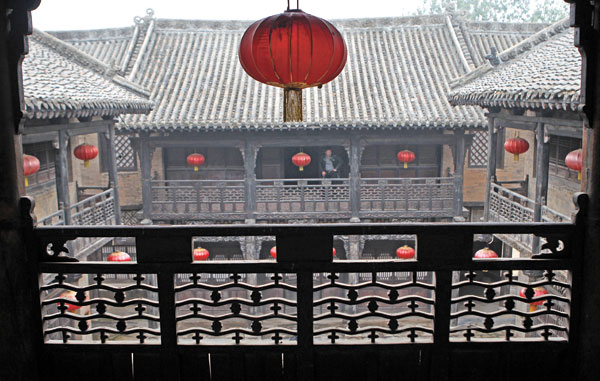Direct reminders of history
The protection of traditional villages doesn't only lie with the architecture, but also in unique elements that reflect the essence of Chinese culture, and in items rich in intangible cultural heritage such as festivals, clothing and tools, according to Lou.
 |
|
A well-preserved traditional couryard in Xiwenxing village. |
He explained that China has more than 5,000 years of history, and documents only record some of that history. Compared with cities, a huge part of China's history happened in villages. Documents are indirect records, but traditional villages are direct reminders.
"Because of the limitations of transport and information in ancient times, China's rural culture and buildings have strong regional characters which can provide historical researchers with high-value evidence," he added.
A Yuan Dynasty stone tower is the landmark of Dazhou village in Gaoping city, Shanxi province. Historically, Dazhou was an important border town and most of the houses were built during the Ming Dynasty. Bluestone roads, high gray walls and black roofs are the main colors seen in the village.
The condition of most of the old houses, with their broken wooden thresholds, railings and beams, is not a cause for optimism. Some have collapsed, spilling piles of bricks across the grass.
"Our ancestors lived in the village for generations and our houses all look alike. Who could have known they would turn out to have a high value? If we had known earlier, more houses could have been saved," said Wei Guocheng, Party chief of the village.
"The county government hired some workers to repair the two temples in the village, but our houses were not included in the renovation plan," he said. "Repairs require traditional techniques and materials and the cost is too high for us. I hope the government or some wealthy benefactors will help us."
Cao Baoming, a member of National Traditional Villages Conservation Commission, said urbanization also poses a huge threat to traditional villages.
"Urbanization will be the theme of China's development for a long time. Sadly, some government officials misunderstood urbanization and thought the process involved demolishing old houses and building new ones. The central government should pay great attention to the issue and should instigate measures to stop urbanization bringing even more harm to high-value traditional villages as soon as possible," he said.
With an increasing number of young people moving away to work in cities, Cao said depopulation is another serious problem for traditional villages.
Xiangyu village in Qinshui town, Shanxi, once had around 1,000 residents but now only around 30 households exist, each with one, or at most two, occupants. The elderly residents have to walk a long way to buy vegetables and daily supplies.
"It's no joke that one traditional village disappears every month. I have been to a village in Jiangxi province where the population comprises just a few elderly people. The houses are locked, leaning over or collapsing. It's a village without smoke at cooking time," Cao said.
Xu Zhenjin, director of the Gaoping Housing and Construction Bureau, said, "China has a long history of farming, therefore we have a large number of traditional villages. It's unrealistic to use government funds to protect all of them and anyway protection requires the efforts of society as a whole. We plan to employ different methods, such as offering preferential policies, ceremonial positions or naming rights to encourage more social organizations to become involved."
Li Huadong echoed Xu's opinion and said the only solution is for villages to attract more funds from social organizations.
"However, the current land policies in rural areas don't allow villagers to transfer ownership, which has become a big obstacle stopping traditional villages from entering the property market and has also dampened many people's enthusiasm to explore tourism opportunities or protection," he added.
For Lou, protecting a traditional village is a more difficult task than protecting the Forbidden City.
"The Forbidden City has lost its original function as a government center, therefore its protection is only focused on architectural maintenance and fire prevention. But people still live in the traditional villages and we need better planning and more help," he said.
Contact the writers at hena@chinadaily.com.cn and linjinghua@chinadaily.com.cn
Renovation and rebirth
|
|
|
|
|
|
|
|
